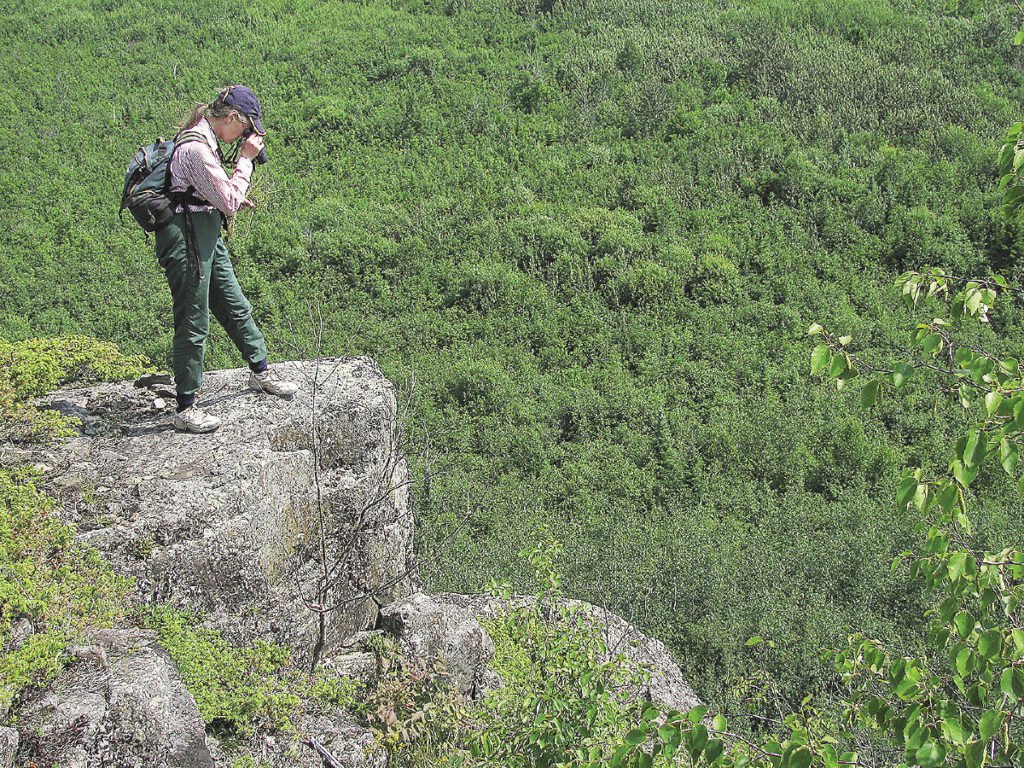Thunder Bay—On an unusually hot and humid June evening in Thunder Bay, four volunteers are hunched over dense greenery along the McVicar Creek Recreation Trail. They’re uprooting garlic mustard, a prolific weed that stifles biodiversity by outcompeting other plant species that are native to this region. This event was a result of a collaboration between EcoSuperior’s Invasive Species Program and the Thunder Bay Field Naturalists (TBFN), a non-profit organization that focuses efforts on the preservation and understanding of regional natural spaces. Collaborations with local organizations are becoming more regular for the TBFN, a group with a long history of running its own events and projects. TBFN president, Bruce Thacker, says that the organization has been especially busy in recent years, forging new local partnerships and collaborating on initiatives. Lack of government funding for environmental efforts has pushed environmental NGOs, like the TBFN, to find alternative ways to pursue their cause.
“If we can’t support something on our own, such as providing an internship, we reach out to other organizations to see if we can share the position,” Thacker explains.
The TBFN first began in 1933, with the club dedicated to the understanding and observation of plant species and wildlife. In the early 1970s, as ideas about conservation emerged, the club incorporated as a not-for-profit company to gain charitable status and access to funding for its activities. Later, with support from various national and provincial bodies, the TBFN launched Project Peregrine (1989) to reintroduce the peregrine falcon to Lake Superior’s North Shore and established the Thunder Cape Bird Observatory (1991) which provides observations of migrating birds to monitoring networks.
Today, the club has about 230 members and runs popular “field trips”—events which are organized every weekend in the spring and summer months. These excursions are not just for members, they are open to the public and participants are required only to RSVP, dress for the weather, and leave any pets at home. Thacker says that these “robust nature hikes” get people out into the natural spaces in and around the city, while bringing people together at the same time. Winter hikes are less frequent, so the TBFN offers a series of public presentations, where speakers are brought in to discuss nature-themed topics. Audiences have reached 80 to 100 people per event.
“It’s really gratifying to see that kind of interest,” Thacker says.
The broader purpose of the field trips and speaker series is part of an effort to get people to consider the possibility that natural spaces can impact us in meaningful ways.
“We tend to become urbanized, even urbanized in our habits and only involved in city activities, that we aren’t making time to get away into a natural setting,” Thacker explains.
Thacker fears that this disconnect between our day-to-day lives and the natural world could lead to our inability to imagine and feel the value of the natural world.
“There is this lack of appreciation for the support that the natural world gives to our daily lives. We continue to abuse nature, take it for granted, and reduce it to monetary value,” he says.
The organization also amplifies the voice of the natural world in other ways. The TBFN has established several Nature Reserves, which are parcels of land preserved solely for the purpose of conservation. Guidelines for the management of these properties protect the land in perpetuity—building, mining, hunting, or resource extraction are prohibited, and dedicated volunteers of the TBFN support the spaces by monitoring them. The TBFN own 16 pieces of property, totaling about 5,000 acres of protected land. Most recently, the TBFN acquired additional land in the Williams Bog, bringing 330 acres of the ecologically significant wetland area under conservation protection. The Nature Reserves are open to the public to visit, but the TBFN stresses that recreation is a secondary use of these spaces. Nature Reserves chair, Susan Bryan, says that the lands are part of the common good and urges people to consider the idea that different lands have different uses.
“If all lands are open for all uses, then everything will be degraded,” she says.
Some species simply cannot co-exist with ATV trails and snowmobiles—but that doesn’t mean there aren’t spaces that can be used for those activities. Allowing certain lands to thrive, such as wetlands and forested areas, helps to naturally mitigate the effects of climate change, which benefits all species, including us. Only allowing low-impact recreation, such as walking, hiking and paddling, ensures that the Nature Reserves offer people an opportunity to meet nature on its own terms.

